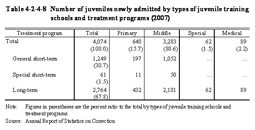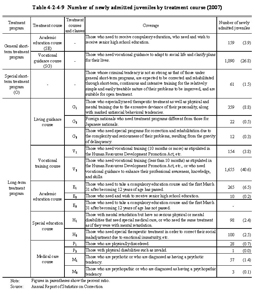| Previous Next Index Image Index Year Selection | |
|
|
2 Treatment of juveniles in juvenile training schools In juvenile training schools, treatment corresponding to individual needs is conducted (individualization of treatment), paying full consideration to each person's personality, good points, future plans, physical and mental conditions, and delinquent tendencies. In order to realize individualization of treatment, the Classification Treatment System is adopted, by way of conducting scientific examination for each juvenile and classifying individuals with common characteristics and educational needs into groups, so as to provide most appropriate treatment for each of such groups. Furthermore, individual treatment plans are prepared and treatment is provided by setting goals, contents and methods according to the stage of each person's improvement. Through such treatment, it is aimed to encourage juveniles to have ambition, expecting that their voluntary efforts should facilitate their own rehabilitation. Treatment in juvenile training schools is divided into three educational stages – orientation stage, intermediate stage, and pre-release stage. Educational goals and contents are set in a progressive manner for each stage. Juveniles are classified into any of the first to third grades, among which the first grade and the second grade are further divided into two grades (upper and lower). Those newly admitted are placed in the lower second grade and then move to other grades according to their improvement. (2) Types of juvenile training schools and treatment programs In juvenile training schools, juveniles are classified by (i) types of juvenile training schools, (ii) treatment programs, and (iii) treatment courses, according to educational necessity and personal characteristics one by one. a. Types There are the following four types of juvenile training schools specified for age, level of criminal tendency, and physical and mental conditions of the juveniles to be received: [i] Primary juvenile training schools For juveniles aged generally 12 or over but generally under 16 without any serious physical or mental disorder; [ii] Middle juvenile training schools For juveniles aged generally 16 or over but under 20 without any serious physical or mental disorder; [iii] Special juvenile training schools For juveniles aged generally 16 or over but under 23 without any serious physical or mental disorder, but with a strong criminal tendency; juvenile prisoners under 16 can also be admitted; and [iv] Medical juvenile training schools For juveniles aged generally 12 or over but under 26 with a serious physical or mental disorder b. Treatment programs Juvenile training schools establish treatment programs that define the administrative detention terms. There are short-term programs and long-term programs, and the former are divided into general short-term programs and special short-term programs. Primary juvenile training schools and middle juvenile training schools implement short-term programs and long-term programs, and special juvenile training schools and medical juvenile training schools implement only long-term programs. Each of these three programs covers the following. [i] General short-term programs For juveniles who can be expected to be corrected and re-integrated into society through short-term, continuous and intensive training, as their problems are simple or relatively minor and are very likely to be settled promptly (the maximum term of detention is six months in principle) [ii] Special short-term programs For juveniles who are less inclined to delinquency than those who are subject to the general short-term program and can be expected to be corrected and re-integrated into society through short-term, continuous and intensive training, as their problems are very likely to be settled promptly, and therefore are suitable for open treatment (the maximum term of detention is four months) [iii] Long-term programs For juveniles who are not suitable for short-term programs (the maximum term of detention is two years in principle) Table 4-2-4-8 shows the number of juveniles newly admitted in 2007 by types of juvenile training schools and treatment programs. Table 4-2-4-8 Number of juveniles newly admitted by types of juvenile training schools and treatment programs (2007) c. Treatment coursesTable 4-2-4-9 shows type and coverage of treatment courses and the number of newly admitted juveniles by treatment course. Table 4-2-4-9 Number of newly admitted juveniles by treatment course (2007) (3) Contents of educationa. Living guidance Living guidance is implemented on the following issues: (i) problems related to juveniles' ways of thinking, attitude, and behavior that could lead to delinquency, (ii) problems related to juveniles' predisposition and emotions, (iii) spiritual enrichment, (iv) problems related to juveniles' basic living skills, law-abiding and self-disciplinary behavior, and interpersonal relationships, (v) problems in relationships with juveniles' family and friends, and (vi) preparation for career selection, life planning, and social rehabilitation, by utilizing various methods, such as interview guidance, essay guidance, diary guidance, and role lettering, etc. In addition, “education from the victims' point of view” programs have been improved and enhanced so that juveniles will understand the actual damage caused by the crime or delinquency they committed and the victims' feelings, etc. and be capable of sincerely responding to their crime victims. b. Vocational guidance Juvenile training schools currently offer vocational guidance on such subjects as welding, woodwork, civil engineering and construction, operation of construction machinery, agriculture and horticulture, office work, and caretaking services, etc. In 2007, 40.3% of the discharged juveniles had obtained qualifications or licenses related to their vocational guidance courses, and 53.1% had obtained qualifications or licenses unrelated to their vocational guidance courses. Fig. 4-2-4-10 shows the percent distribution of the qualifications or licenses obtained in 2007. Fig. 4-2-4-10 Percent distribution of the qualifications or licenses obtained by juveniles discharged from juvenile training schools (2007) Securing employment after discharge from juvenile training schools is extremely important to establish juveniles' livelihood after discharge and prevent them from repeating delinquency and thereby realize their improvement and smooth reintegration into society. Comprehensive job assistance services to help discharged juveniles find jobs started in April 2006 (see Part 2, Chapter 5, Section 2, 2 (9)). In juvenile training schools, explanation on this service is given from the early stage after juveniles are admitted and appropriate vocational guidance is provided. For juveniles who are going to be discharged soon, juvenile training schools and public employment agencies jointly provide support for their job search through vocational counseling, job introduction, and provision of job/employment information.c. Academic education Among juveniles in juvenile training schools, those who have not completed compulsory education, and those who need and wish to receive senior high school education are placed under academic education courses and receive academic education. Academic education for juveniles who are not in academic education courses is provided to meet the needs of the juveniles, such as basic scholastic ability necessary for social life, and scholastic ability development to proceed to higher education or return to the schools to which they had belonged. Some institutions implement compulsory education or senior high school education through academic education programs entrusted to schools, etc. outside of the juvenile training school. Of the juveniles discharged in 2007, 144 returned to junior high schools, while 143 returned to senior high schools. A total of 340 juveniles had received the graduation certificates of junior high schools while in juvenile training schools (Source: Annual Report of Statistics on Correction). Also, it is made possible to conduct a high school equivalency examination in juvenile training schools since FY2007. In FY2007, 216 juveniles took the examination, 62 passed the equivalency examination, and 147 passed a subject (Source: The Ministry of Education, Culture, Sports, Science and Technology). d. Health and physical education Doctors and medical staff of institutions provide health and physical education on disease prevention, etc. to enhance juveniles' ability to maintain good health, taking into consideration their previous delinquency and living styles. Furthermore, in physical education, various sports activities are organized to enhance their basic physical abilities, concentration, patience, and endurance, and group games are utilized to develop compliance with rules and cooperation in interpersonal relationships. e. Special activities Special activities include (i) voluntary activities, (ii) extramural educational activities, (iii) club activities, (iv) recreation and (v) other events. As for voluntary activities, juveniles are assigned roles such as a day manager, a book manager, a maintenance manager, a recreation manager, etc. to develop autonomy and cooperativeness at most juvenile training schools. Furthermore, meetings and homeroom activities are organized and in-house magazines are created by them. Volunteer work and field trips are conducted as extramural educational activities. As volunteer work, many schools implement activities at welfare facilities and cleaning/beautification activities at nearby parks and public facilities, etc. (4) Medical care Of those discharged from juvenile training schools in 2007, 1,105 (25.1%) had received some kind of medical treatment in sick rooms in schools, including those who received treatment in medical juvenile training schools. By type of illness, breathing problems had the largest share at 67.9%, followed by mental or behavioral disability (9.8%), and digestive problems (6.2%) (Source: Annual Report of Statistics on Correction). (5) Measures for guardians In order to enhance the effectiveness of correctional education at juvenile training schools it is important to ensure that guardians recognize their responsibility for the custody of the accommodated juvenile, etc. Measures such as providing guidance and advice are therefore being taken systematically through making available information on correctional education, staff conducting interviews, promoting participation in educational activities, and actively holding parent meetings and workshops, etc. (6) Cooperation and assistance from the private sector to treatment Juvenile training schools provide education in cooperation with nongovernmental volunteers in many ways. People across society, such as volunteer visitors, chaplains, members of the Women's Association for Rehabilitation Aid, and members of the BBS associations conduct supportive activities as private volunteers. Volunteer visitors give juveniles advice and guidance on mental problems and cultural guidance, etc. As of December 31, 2007, 660 persons are consigned as volunteer visitors for juvenile training schools (Source: The Correction Bureau, Ministry of Justice). Chaplains provide religious education at the request of juveniles. Juvenile training schools had 374 chaplains as of December 31, 2007 (Source: The Correction Bureau, Ministry of Justice). Members of the Women's Association for Rehabilitation Aid and members of the BBS associations regularly visit each juvenile training school to participate in school events such as birthday parties, cherry blossom viewing parties, and Coming of Age ceremonies, enjoy playing games and sports with juveniles, or participate in speak-outs as judges. Such volunteers offer support for educational activities in juvenile training schools in various ways. Interaction with these volunteers serves as a significant encouragement for juveniles in rehabilitating themselves. |


